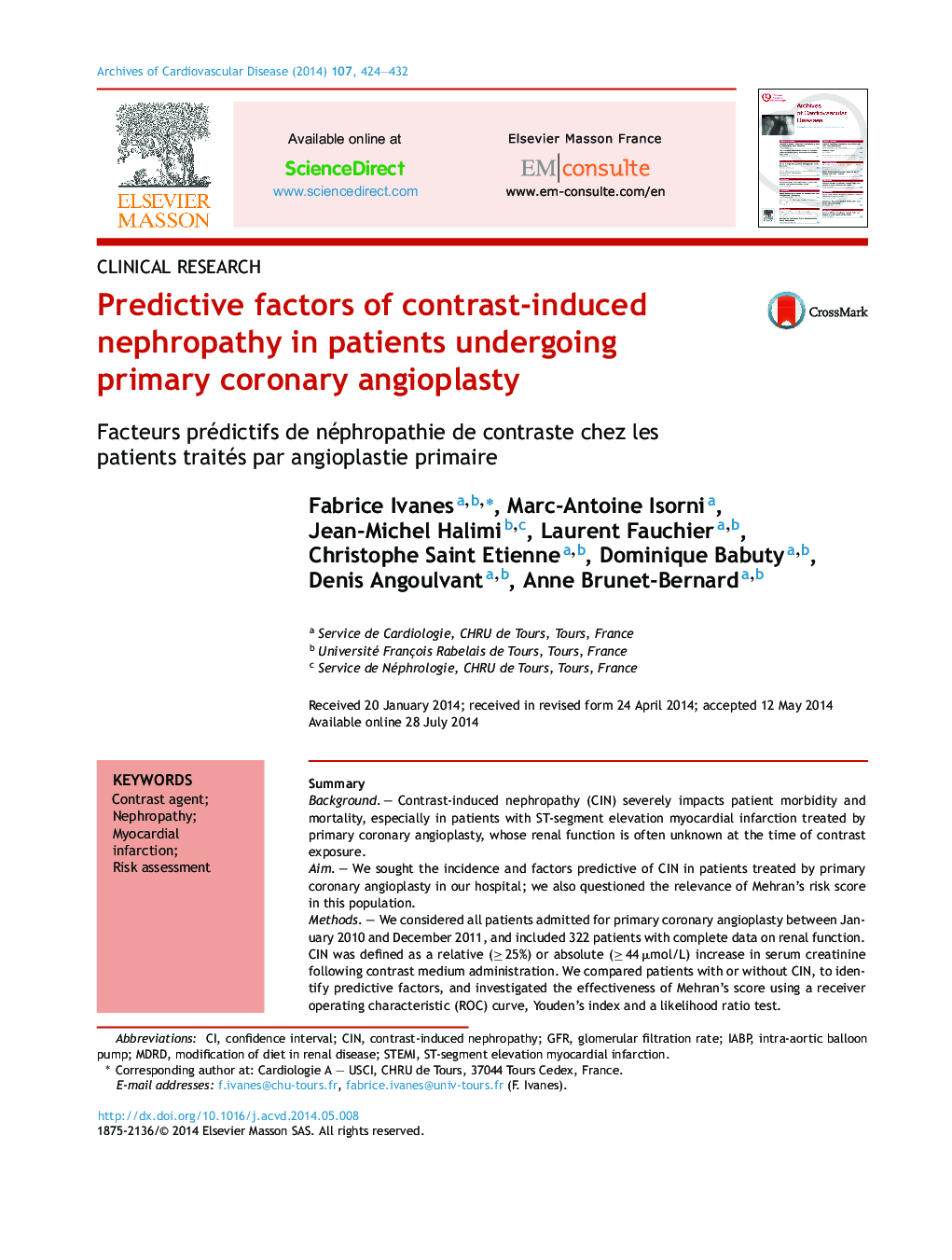| کد مقاله | کد نشریه | سال انتشار | مقاله انگلیسی | نسخه تمام متن |
|---|---|---|---|---|
| 2888918 | 1574352 | 2014 | 9 صفحه PDF | دانلود رایگان |
SummaryBackgroundContrast-induced nephropathy (CIN) severely impacts patient morbidity and mortality, especially in patients with ST-segment elevation myocardial infarction treated by primary coronary angioplasty, whose renal function is often unknown at the time of contrast exposure.AimWe sought the incidence and factors predictive of CIN in patients treated by primary coronary angioplasty in our hospital; we also questioned the relevance of Mehran's risk score in this population.MethodsWe considered all patients admitted for primary coronary angioplasty between January 2010 and December 2011, and included 322 patients with complete data on renal function. CIN was defined as a relative (≥ 25%) or absolute (≥ 44 μmol/L) increase in serum creatinine following contrast medium administration. We compared patients with or without CIN, to identify predictive factors, and investigated the effectiveness of Mehran's score using a receiver operating characteristic (ROC) curve, Youden's index and a likelihood ratio test.ResultsThe incidence of CIN was 9.1%. A multivariable analysis identified two independent risk factors for CIN: impaired glomerular filtration rate and cardiogenic shock at admission (P < 0.05). An elevated Mehran's score was associated with increased incidence of CIN, but statistical analysis revealed this score to have poor sensitivity, especially in high-risk patients. Youden's index was very low and the area under the ROC curve was 0.59 in our population.ConclusionRenal failure and cardiogenic shock at admission were independent predictors of CIN in our acute myocardial infarction population. Mehran's score added little to the discrimination of patients undergoing primary coronary angioplasty, particularly high-risk individuals.
RésuméContexteLa néphropathie de contraste impacte le pronostic des patients admis pour infarctus du myocarde avec sus-décalage du segment ST traités par angioplastie primaire, pour qui la fonction rénale est généralement inconnue lors de la prise en charge.ObjectifNous nous sommes intéressés à l’incidence de la néphropathie de contraste chez les patients admis dans notre centre pour angioplastie primaire et avons cherché à déterminer l’applicabilité du score de risque de Mehran dans ce contexte.MéthodesNous avons inclus 322 patients entre janvier 2010 et décembre 2011. La néphropathie de contraste était définie comme une élévation relative (≥ 25 %) ou absolue (≥ 44 μmol/L) de la créatininémie au décours de l’injection de produit de contraste. Nous avons évalué la pertinence du score de Mehran en comparant patients avec ou sans néphropathie de contraste en utilisant des rapports de vraisemblance, index de Youden ou courbe ROC.RésultatsL’incidence de la néphropathie de contraste était 9,1 %. En analyse multivariée, seuls l’insuffisance rénale préexistante et le choc cardiogénique à l’admission étaient prédictifs de néphropathie de contraste (p < 0,05). Un score de Mehran élevé s’accompagnait d’une augmentation d’incidence de néphropathie de contraste mais la sensibilité de ce test restait faible, en faisant un outil peu utile comme en témoignaient les index de Youden bas et l’aire sous la courbe ROC à 0,59.ConclusionInsuffisance rénale et choc cardiogénique apparaissent comme les seuls prédicteurs de néphropathie de contraste chez les patients admis pour infarctus du myocarde. L’utilité du score de Mehran n’apparaît pas démontrée dans cette population.
Journal: Archives of Cardiovascular Diseases - Volume 107, Issues 8–9, August–September 2014, Pages 424–432
